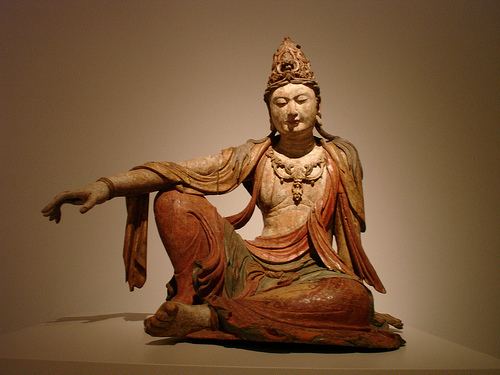Traditional Chinese 大勢至 Hanyu Pinyin Wylie Thu-ch´en-Thob | Simplified Chinese 大势至 Wade–Giles Ta-shih-chi Vietnamese alphabet Đại Thế Chí Bồ tát | |
 | ||
Mahāsthāmaprāpta is a bodhisattva mahāsattva that represents the power of wisdom, often depicted in a trinity with Amitābha and Avalokiteśvara (Guanyin), especially in Pure Land Buddhism. His name literally means "arrival of the great strength".
Mahāsthāmaprāpta is one of the Eight Great Bodhisattvas in Mahāyāna Buddhism, along with Mañjuśrī, Samantabhadra, Avalokiteśvara, Akasagarbha, Kṣitigarbha, Maitreya and Sarvanivarana-Vishkambhin.
In Chinese Buddhism, he is usually portrayed as a woman, with a likeness similar to Avalokiteśvara. He is also one of the Japanese Thirteen Buddhas in Shingon. In Tibetan Buddhism (Tantrism), Mahāsthāmaprāpta is equated with Vajrapani, who is one of his incarnations and was known as the Protector of the Buddha.
Mahāsthāmaprāpta is one of the oldest bodhisattvas and is regarded as powerful, especially in the Pure Land school, where he takes an important role in the long Sutra of Infinite Life. He is also associated with the temple guardians Kongo Rikishi across Japan.
In the Shurangama Sutra, Mahāsthāmaprāpta tells of how he gained enlightenment through the practice of Buddha recitation, or continuous pure mindfulness of Amitābha, to obtain samādhi. In the Contemplation Sutra, Mahāsthāmaprāpta is symbolised by the moon while Avalokiteśvara is represented by the sun.
Metaphorical manifestation
Monk Yinguang (印光), a teacher of Pure Land School, was widely considered to be a metaphorical manifestation of him after a Christian who said to have never heard of him before and a student of him dreamed of that independently.
